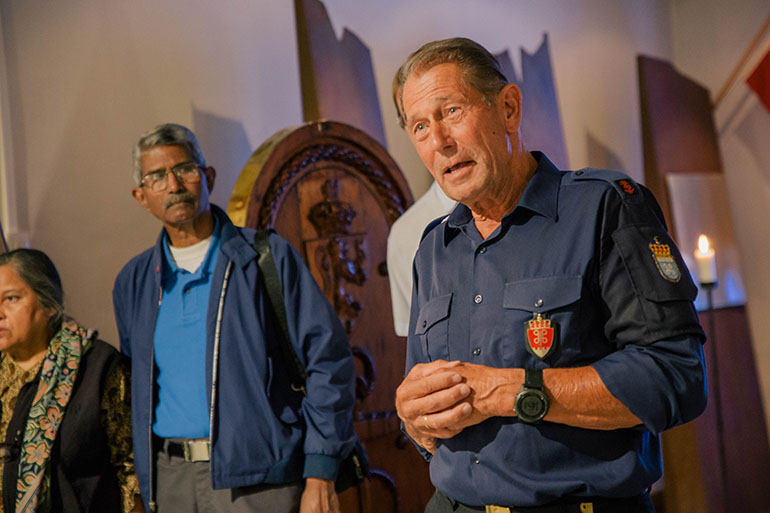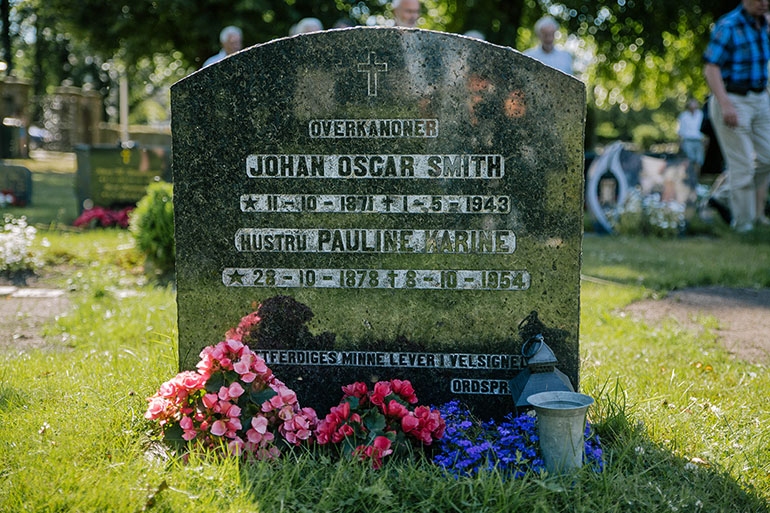During the summer’s international conferences, bus trips were arranged to the Naval Museum at Karljohansvern and to Johan Oscar Smith’s grave in Horten. Informative guides made the trip instructive and inspiring for all those who took part.
Text: Tom Blekstad – Photo: Gadiel Lazcano
But what is it that makes both young and old from several parts of the world use a lovely summer’s day to visit the home town and grave of a man that received his naval training in Horten 130 years ago?
We were hoping to recieve the answer as we followed a group of young and old from 10 different countries through the beautiful and impressively well-preserved Karljohansvern, Norway’s main Naval base since 1850.
“Such trips have been arranged a number of times” Morten Haukelidsæter and Karl Pedersen explain. They are from BCC’s local church in Horten, and are guides for the guests who have come here to learn more about J. O. Smith and the origins of the Church early in the 1900’s.
“The trips began on a small scale more than 10 years ago, in response to a number of requests. Since then, interest has increased. Last year, the tours became a part of BCC’s standard offer to summer conference guests” Haukelidsæter explains, before he gathers the group to begin the tour.
Johan O. Smith Startet his Military career at Seventeen
– One cold and unwelcoming day 23rd January 1889 17-year-old Johan Oscar Smith crossed this bridge, Morten Haukelidsæter tells us. He had applied and been accepted to the Naval Corps at Karljohansvern, which at that time was the training institute for the Navy and the most important naval base in Norway. The harbor was deep enough for warships, the fjord was well guarded, and there was plenty of room for naval maneuvers.

Morten Haukelidsæter and Karl Pedersen from Horten introduce the day’s guided tour of Karljohansvern. Photo: BCC
Young Smith had already been at sea for two years, having started at middle school in the autumn of 1886 in his birthplace Fredrikstad. At the school, he experienced things which made him aware of the unrighteousness in the society of those days. He couldn’t ignore this, and he decided to quit after only half a year. He did so in spite of the good grades he achieved at the school, because he saw how differently the teachers treated those who weren’t sons of civil servants or officers.
Smith stood up for His Class Mates
In those days, there were two training classifications: one for non-commissioned officers, and one for the Naval Academy. Non-commissioned officers had a lower status than those at the Naval Academy. This led to unfair treatment and respect of persons among those who were being trained as non-commissioned officers. Johan Oscar Smith did not hesitate to stand up for his class-mates. He had learnt at home that God was no respecter of persons, as Paul wrote in two of his letters. Irrespective of who or what it concerned, this treatment conflicted with his view of life.
For nine years the work varied between school and service on the naval base in Horten and voyages to foreign countries. The first four years Johan scarcely left the naval base and its vessels. The training voyages took a long time and went to the Mediterranean, Africa, Central America and North America. In a letter from that time he advises his younger brother not to be enticed by a life at sea. «It is the same as suffering evil for the sake of a living» he writes to his youngest brother Ludvik.

The barracks at Karljohansvern where the Naval Academy Corps was quartered. The students (cadets) lived in the barracks and were given free board, lodging and uniforms, as well as pay. Photo: BCC
Johan O. Smith became Best Man of His Year
Following their training, most students were discharged, but were duty-bound to serve in the case of a war threat. Only the best students could be employed by the navy, and these had to commit themselves to 5 years’ service. Johan Oscar Smith was the best student in his year and was therefore the first candidate for higher rank positions. Over the course of time he was promoted to Chief Gunner and offered the position as Administrator of the main arsenal.
He was also offered the opportunity to work for the Admiral. Smith was regarded as conscientious, hard-working, clever and righteous in all that he did. For this reason, he was both respected and well-liked.
Smith’s Conversion
The young Johan Oscar came from a good Christian home and had learnt to value righteousness and honesty in work. Even though he was successful in his choices, nonetheless he remained unsatisfied. He had a strong need to surrender himself completely to God.
– Smith had been to a service at the Methodist Church and later had night watch on the monitor “Thor”. At one thirty in the morning, he entered the ship’s turret and experienced something special. He went on his knees and prayed and then was filled with joy and felt God was very near.
The retired doctor and guide Jakob Prytz tells us about this as we stand in front of the model of a gunboat similar to the one that Smith went on board. – this must have been the start of a new life, and Smith began to tell about this among the naval crews, Prytz tells us.

The retired doctor and museum guide Jakob Prytz explains with emphasis and respect. It is worth noting that the Naval Museum is the world’s oldest one still operating, and here you can find amongst other things, a model of a gun boat resembling the “Thor”, in which Smith got converted. Photo: BCC
Baptism of the Spirit Onboard a Gunboat
Two years later, in the autumn of 1900, Smith was on board the gunboat “Sleipner”. Here he experienced what Christians call Baptism of the Spirit. After this, the scriptures became much easier to understand. He now understood the way to, and the meaning of, a personal inward life in God with victory over sin. This made him free and happy and it gave him a great longing to testify of his faith.
Most of the believers of that time found it difficult to understand him, and many were strongly provoked by what he preached. However, bit by bit, over the years, there were others, also individual officers, seamen and naval employees, who shared his faith.
Read also: Did you say Smith’s Friends?
Faithful to the Country and Society
Smith spent all his adult life in the Norwegian Navy. In opposition to the political opinions of that time, as well as free churches and assemblies, he was convinced that it was God’s will to defend one’s country and society and sacrificed one’s life if necessary. – We see clearly nowadays how important it is with a strong defense. That is how Smith saw it already at that time. He wanted to fight for a strong defense and a free fatherland, our guide explains further.
During the First World War, Smith sailed on neutrality-watch along the Norwegian coast line. In the course of this, together with other naval personnel who he had won by his faithfulness, he visited free churches and assemblies when on land. This was the seed that led to many local churches growing up from south to north along Norway’s long coastline.
Read more: From One man to a Wordwide Church Community

Karl Pedersen explains excitedly about the naval man and the church’s founder Johan Oscar Smith. Photo: BCC
The Life of Johan O. Smith Creates a lasting Impression
Smith died on the night of May 1, 1943, while Norway was at war, and considerable travel restrictions were in place in the country. However, there has never been so many visitors and local participants at a funeral in Horten as at Smith’s funeral on May 8, 1943.
Read more: John Oscar Smith’s Legacy
Standing in front of Smith’s grave-stone, after a tour of Karljohansvern and the Naval Museum, respect for such a man is easy to see on the many faces. Smith was not a superficial person, not in his work or in his faith. He was thorough, gifted and righteous, and above all, godfearing. He used his life and his abilities to bring forth a living faith in God, a faith that is able to totally inwardly transform us, when we acknowledge our sin and obey His word.
On the gravestone is engraved the well-known verse from Proverbs; «The memory of the righteous is blessed». These words take on a deeper significance on this day, and a lasting impression from such a meaningful life follows us from Horten on our way home.


Old and young from Switzerland, Germany, Mexico, USA, Canada, India, Singapore, Denmark, Holland and Norway in quiet contemplation by Johan Oscar Smith’s grave in Horten Friday 14th July. Photo: BCC

